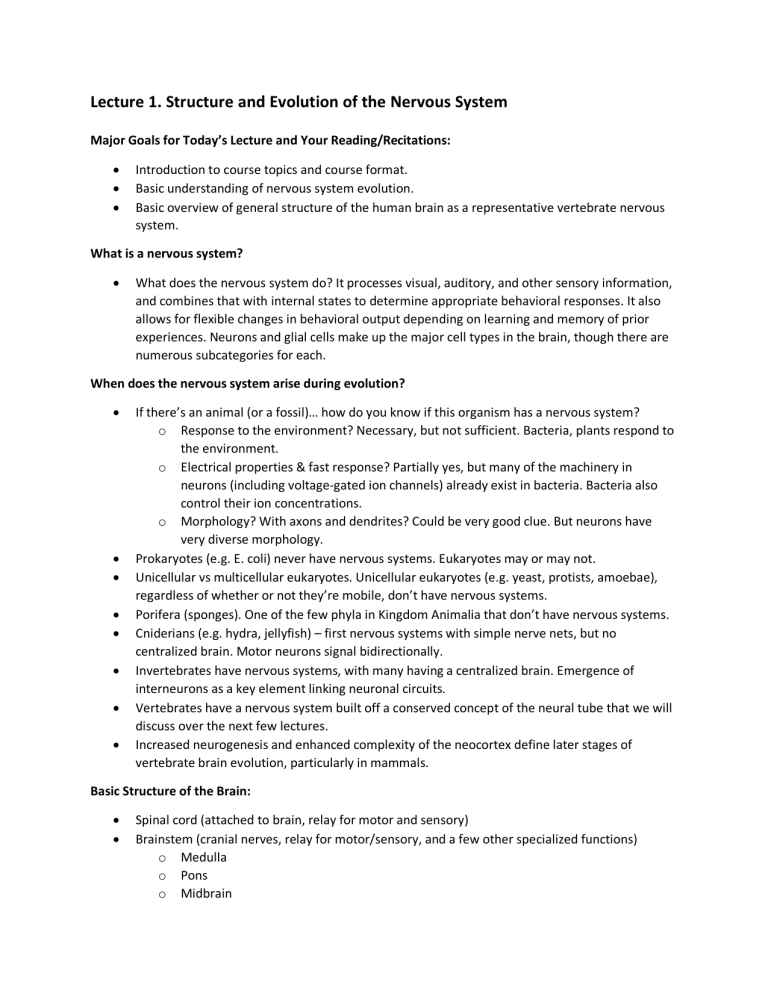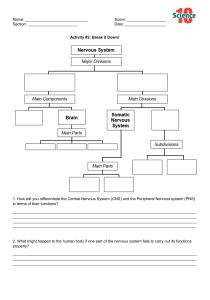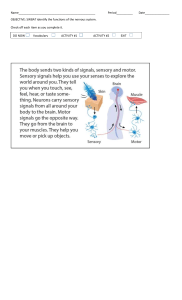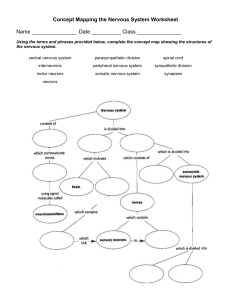
Lecture 1. Structure and Evolution of the Nervous System Major Goals for Today’s Lecture and Your Reading/Recitations: • • • Introduction to course topics and course format. Basic understanding of nervous system evolution. Basic overview of general structure of the human brain as a representative vertebrate nervous system. What is a nervous system? • What does the nervous system do? It processes visual, auditory, and other sensory information, and combines that with internal states to determine appropriate behavioral responses. It also allows for flexible changes in behavioral output depending on learning and memory of prior experiences. Neurons and glial cells make up the major cell types in the brain, though there are numerous subcategories for each. When does the nervous system arise during evolution? • • • • • • • • If there’s an animal (or a fossil)… how do you know if this organism has a nervous system? o Response to the environment? Necessary, but not sufficient. Bacteria, plants respond to the environment. o Electrical properties & fast response? Partially yes, but many of the machinery in neurons (including voltage-gated ion channels) already exist in bacteria. Bacteria also control their ion concentrations. o Morphology? With axons and dendrites? Could be very good clue. But neurons have very diverse morphology. Prokaryotes (e.g. E. coli) never have nervous systems. Eukaryotes may or may not. Unicellular vs multicellular eukaryotes. Unicellular eukaryotes (e.g. yeast, protists, amoebae), regardless of whether or not they’re mobile, don’t have nervous systems. Porifera (sponges). One of the few phyla in Kingdom Animalia that don’t have nervous systems. Cniderians (e.g. hydra, jellyfish) – first nervous systems with simple nerve nets, but no centralized brain. Motor neurons signal bidirectionally. Invertebrates have nervous systems, with many having a centralized brain. Emergence of interneurons as a key element linking neuronal circuits. Vertebrates have a nervous system built off a conserved concept of the neural tube that we will discuss over the next few lectures. Increased neurogenesis and enhanced complexity of the neocortex define later stages of vertebrate brain evolution, particularly in mammals. Basic Structure of the Brain: • • Spinal cord (attached to brain, relay for motor and sensory) Brainstem (cranial nerves, relay for motor/sensory, and a few other specialized functions) o Medulla o Pons o Midbrain • • • o Cerebellum (comes off the pons, regulates motor/sensory coordination) Thalamus. Important integratory system. Receives sensory information, and sends information to rest of cortex. Hypothalamus. Below the thalamus. Major endocrine regulator. Involved in secreting many hormones controlling behaviors. Can secrete things directly, or can send signals to the pituitary gland to secrete things. Circadian rhythm, sexual behavior, maternal/paternal behavior, thirst, feeding. Cerebrum – four brain lobes of the cortex. Occipital lobe: back of brain, responsible for vision. Frontal lobe: motor control, motor planning and the prefrontal cortex responsible for attention, decision-making, working memory, etc. Parietal lobe: Visual-spatial cognition. Temporal lobe: auditory cortex, language cognition, home to the Amygdala (Fear and reward), Hippocampus (learning center) and Basal ganglia (learned motor sequences/habits.





